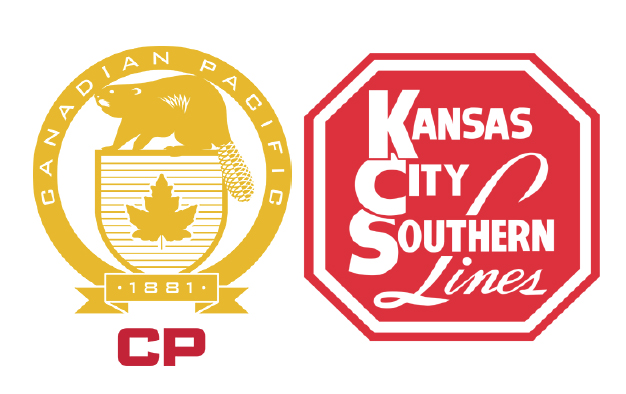
Will Canadian Pacific’s proposed acquisition of Kansas City Southern be the spark that ignites the final round of railroad consolidation in North America? It’s a question that’s been coming up since CP and KCS announced their blockbuster $29 billion deal on March 21.
Most analysts agree that CP+KCS won’t lead to the creation of two go-everywhere systems that span the continent. But there are two schools of thought on the matter.
The first says that combining CP and KCS creates a stable, competitively balanced North American railroad map: BNSF Railway and Union Pacific in the West, CSX Transportation and Norfolk Southern in the East, and two Canadian systems that reach the Gulf Coast and, in the case of CP, deep into Mexico. This means that no countermoves are required by the other Class I systems. And so the creation of Canadian Pacific Kansas City will not prompt more mergers.
But the other line of thinking takes exactly the opposite approach: This balance sets the table for eventual mergers involving the big Eastern and Western U.S. systems and the Canadian railways.
Michael Haverty – who as chief executive outmaneuvered Union Pacific and turned KCS into a U.S.-Mexico cross-border system 25 years ago – says no final round of mergers would be possible with KCS still an independent railroad. So the CP-KCS combo will, in Haverty’s view, lay the groundwork for the merger endgame, although he doesn’t believe that will happen in the immediate future.
That’s an intriguing scenario. And, in typical Haverty fashion, it makes sense.

Could CP+KCS Be a Test Case for Mergers?
The plot thickens when you consider a merger hint that BNSF dropped into a letter to federal regulators last week.
But first, some background is in order. CP and KCS want their deal reviewed under the Surface Transportation Board’s old merger rules. KCS, as the smallest Class I, received a waiver from the STB’s much tougher 2001 rules that cover major mergers.
Four of the other five Class I railroads, along with nine shipper associations, have asked the STB to judge the CP-KCS deal under the current merger rules. Those rules require, among other things, for the combining railroads to show their deal enhances competition, is in the public interest, and to consider so-called “downstream effects” such as how the merger might prompt further consolidation in the industry.
This high hurdle has stymied Class I railroad mergers for the past two decades. The 2001 rules remain untested, as no Class I’s have shown up at STB headquarters and plunked down a merger application. This, BNSF noted in its filing with the STB last week, has created uncertainty regarding how the 2001 merger rules would be applied.
“BNSF believes that as a matter of policy, the public and freight rail stakeholder community would benefit in the future from the guidance gained by the Board’s application of its current standards to this and all future transaction proposals,” wrote BNSF Chief Legal Officer Roger Nober, who served as chairman of the STB from 2002 to 2006.
In other words, BNSF views CP-KCS as something of a test case. If the STB ultimately approves CP-KCS under the 2001 merger rules, that alone could one day pave the way for megamergers because there would be a blueprint for how to get a deal through Washington.
Support for Small Deal May Erode with Megamerger
But we’re a long way from that right now. CP+KCS is not in the same league as, say, BNSF+NS. Shippers, while showing support early on for Canadian Pacific Kansas City, may not be in a mood for a railroad whose tracks would reach from Los Angeles and Seattle to New York and Miami. And Wall Street analysts expect that any benefits of a merger of two big Class I systems would be entirely offset by onerous conditions regulators would impose, from open access to expensive environmental mitigation.
For now we’ll just have to wait and see how the CP-KCS deal shakes out. But one thing’s clear: Mergers expand the reach of a railroad, making it a better competitor with trucks that can go anywhere. So one day a megamerger, and the final round of consolidation, will give railroads a fighting chance against the truckers who have been eating the industry’s lunch for decades.
You can reach Bill Stephens at bybillstephens@gmail.com and follow him on twitter @bybillstephens














Perhaps they are looking at this as a test case. They may also be hoping to get something if the higher standard of the new rules force CPCK to grant more competitive access.
The merger itself doesn’t change the competitive landscape much. It would allow CP to provide single carrier service from Mexico to Canada and the Northeast. In some cases, this would be a longer route than if CP or KCS interchanged the traffic with another Class I. If certain gateways with other Class Is were required to be kept open, the competitive landscape doesn’t change much. The only other Class I that might be disadvantaged is CN, who might desire their own access to Mexico. However many miles separate CN from Ferromex. The best CN could hope for is open Gateways with CP at Meridian MS, Springfield, IL, and in the St. Louis area, or possibly car ferry service from the US.
If required by the STB, the new rules require increased competition, not just preserved competition. I don’t see this deal as a test case since it is nothing close to the scope of a transcontinental merger. However, the procedure for getting approval would be the same. It would require the merging railroads to provide sufficient trackage rights, open gateways open access, and other conditions to convince the STB that competition is increased by the merger. For CP-KCS, that should be achievable if management is willing to make deals to gain the support of shippers and other railroads. For other Class Is, the concessions would need to be much greater.
Landon; it probably isn’t a test case per se but; it would indicate how the newer merger rules actually play out before the board in an end to end merger. This process would then be informative to any Class 1’s considering a merger in the future.
I’ve always been skeptical of a further round of mergers. CP+KCS won’t, in my opinion, trigger anything more. That’s just my guess.
Bill; I think you hit the nail on the head that BNSF considers this proposed merger a test case. I also suspect that’s why NS and UP filed comments urging the board to waive KCS’ exemption from the large merger rules. In fact, I was somewhat surprised CSX didn’t see the wisdom in seeing how a merger proceeding would go under the new rules.
Why in the world doesn’t SBT want to help railroads. They certainly in 2001 set up roadblocks to the mega merger. But just as Bill said the megamerger would give the railroads a much better chance against the truckers but as usual the government continues to put up hurdles in the way of the railroads. What authority did SBT have to write new regulations? The SBT is just the same old ICC with a different name where members like to flex their muscles and enjoy the power they have.
How on earth can you possibly think that further consolidation will “give the railroads a much better chance against the truckers”? Their service lanes are largely monopolies now. Every Class 1 has been doing some version of PSR, which effectively shuts down service lanes and forces customers to use trucks. What about the past 15 years contradicts this view? Bill Stephens has written how entire commodity groups, largely car load freight, have tanked in the past 15 years. This is about monopolies and financialization of the industry, not about customer service, the environment or much beyond the next quarter or when executive stock options are in the money…